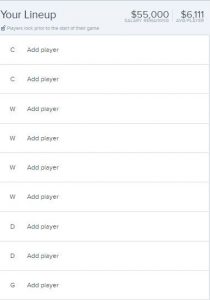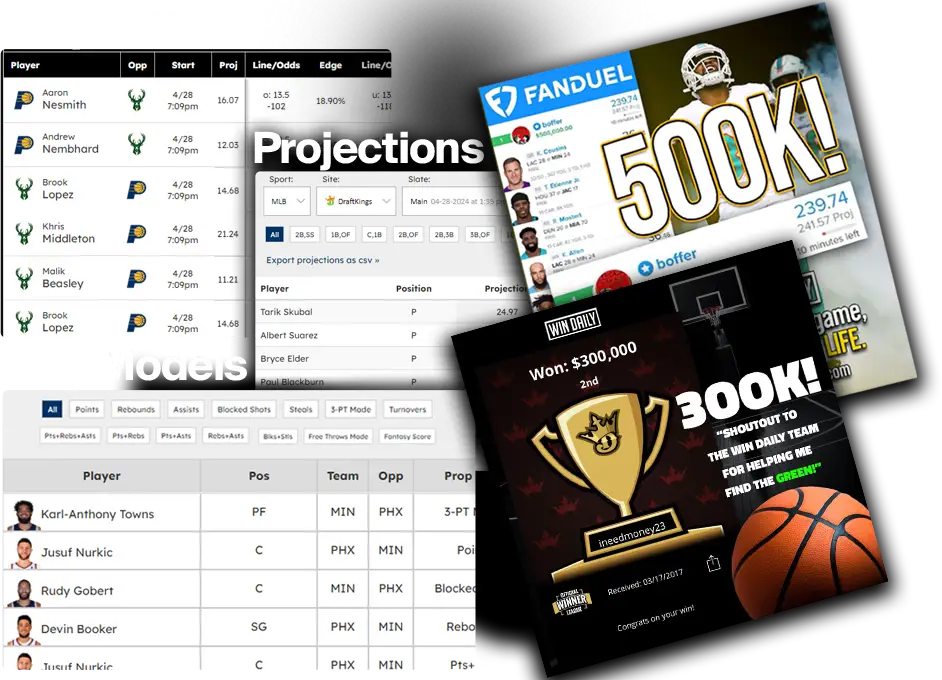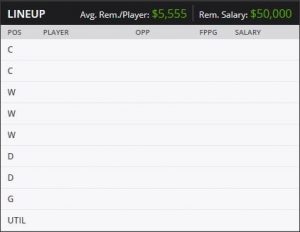Hi everyone and welcome to the first NHL DFS article here at Win Daily Sports. I am very excited for the season to get underway so we can start winning together! Before the season begins, let’s explore the strategies I employ when making DFS lineups and hopefully, you too will become a successful NHL fantasy player!
Before we take a look at methods and important statistics, we need to have an overview of how to play NHL DFS on both FanDuel and DraftKings. Both sites require you to choose nine players. On FanDuel, these are two centers, four wingers, two defensemen and a goalie with a total salary of $55,000. Whereas on DraftKings, there are two centers, three wingers, two defensemen, a goalie, and a utility player with a total salary of $50,000. Blank squads look as such.

Point breakdowns for each site are similar for the most part, but there are subtle differences that you should be aware of before building your line. Here is an analysis of each category.
| Player Points | FanDuel | DraftKings |
| Shots | +1.6 | +0.5 |
| Blocked Shots | +1.6 | +0.5 |
| Goals | +12 | +3 |
| Assists | +8 | +2 |
| Power Play Points Bonus (Goals/Assists) | +0.5 | — |
| Short Handed Points Bonus (Goals/Assists) | +2 | +1 |
| Hat Trick Bonus (3 Goals) | — | +1.5 |
| Shootout Goals | — | +0.2 |
| Goalie Points | FanDuel | DraftKings |
| Saves | +0.8 | +0.2 |
| Goals Against (Excludes Empty Netters) | -4 | -1 |
| Wins | +12 | +3 |
| Shutouts | +8 | +2 |
| Goals | — | +3 |
| Assists | — | +2 |
GENERAL NOTES:
- It is plausible that someone can be credited with a goal without intending to score or even without shooting the puck
- There are a maximum of two assists on a goal and a minimum of zero
- There are no assists on Penalty Shots.
- In-game penalty shots will count as Goals Against for a goalie if scored but penalty shootout goals will not.
- NHL is a late-swap sport so each player will lock when their respective game starts.
- FanDuel is generally slower at updating player prices than DraftKings.
NHL DFS Goalies
Goalies are the heart of any NHL DFS fantasy lineup, and more often than not they will be the difference between cashing or not. If you want to take down a GPP, a successful goalie is vital. There are some predictors to help you determine whether or not your goalie will have a good outing on any particular night. The first is whether or not the goalie is hot or cold. At an NHL level a goalie’s mental state is everything, and if they are experiencing a cold streak it is challenging to shake off even for the best goalies. That is why when choosing a goalie, it helps if they have a positive record over their previous five starts. In terms of statistics, there are two clear indicators to measure how many goals they allow per game (goals-against average or GAA) and how many shots they stop per game (save percentage or SV%). In general, it is preferable that your goalie has maintained a goals-against average below 3.00 and save percentage of at least .910 entering that game.
Probably the most essential and clear-cut factor in predicting a goalie’s success is whether or not they are favored to win and if the over/under is low. Vegas statisticians employ many different factors when they predict the success rate of any team, and more often than not, they tend to be correct. Every NHL arena is different, and some goalies feel more comfortable on a particular ice surface than others, so it is also vital to look at a goalie’s record at that specific arena, to gauge their likelihood of success. It is also important to avoid goalies if they play two days in a row since fatigue is a very important factor for predicting performance between the pipes. My final tip for NHL DFS goalies is do not be afraid to spend up at this position or even put them as the first player in your line. As mentioned earlier, the goalie is the heart of your team, and your success depends on their performance.
Furthermore, all goalies tend to be rather expensive, to begin with, due to the high upside, so there isn’t a massive jump between a stud goalie and a value goalie. For starting goalie updates I use Left Wing Lock’s Starting Goalie Tracker. They use up to the minute information to determine which goaltender is most likely to start each matchup and provide confirmation once a goalie is selected.
NHL DFS Stacking
Stacking is the strategy that is integral to success in NHL DFS. When it comes to stacking in hockey, it is much more straightforward than with most other sports. The main idea is stacking players alongside their even strength linemates. Generally, you will want to reserve two-player stacks for cash games and focus three-player stacks for GPPs since ideally if a line is in form, all three players will benefit. More often than not the winner of large-field GPPs will have two full line stacks along with two defensemen and a goalie who performed well. I like to break down my stacks into two different groups, either of which can be useful in completing your lineup.
The first is a “Top Tier” Stack, this is where the two or three players you have on the same team are on the ice at the same time at even strength, and on the power play. This is ideal since the players will maximize the amount of time they have on the ice together. The second option is a “Mid Tier” Stack, and this is where the players are on the ice together during even-strength but are not on the same power play. Do not be afraid to play mid-tier stacks, as especially with bargain stacks it is not always the case that they see power-play time together, but they could be very hot coming into the game and up against a struggling or tired goalie. Not to mention, there are some instances where a bargain player working alongside a star player during even-strength will not play on their power-play unit, but will still represent an excellent value play due to their price.
As a NHL DFS general rule any team’s top two lines would be considered the most “stackable” as they will see the bulk of the ice time, however, third line one-offs and stacks could also provide decent value under the right circumstances. Generally, stay away from fourth lines on principle, they will usually only see around 5-10 minutes of ice time per game and are most often the least talented players on their team. (There are rare occasions where fourth line one-offs may be appropriate for GPPs, such as if a fourth liner sees power play time.)
Since stacks are as vital to NHL DFS success, it is also important to be attentive to line changes and general NHL news. Line changes are usually confirmed in the team’s morning skate which takes place the day of the game. Line changes could occur for many reasons including coaching inclinations, poor/promising performance, injuries and suspensions. A cheap option could replace an injured or suspended player on a top line, which would quickly increase their value. Be sure to check line updates at dailyfaceoff.com. It is wise to check at some point in the afternoon EST after the morning skate. Most lineups should be finalized by then.
NHL DFS Defensemen
Generally speaking you want defensemen who play alongside the top two lines of favored teams and especially alongside stud players. Ideally your defensemen will see around 20 minutes of ice time per game and will appear on one of their team’s two power play units. Power play time isn’t necessary but it is definitely recommended. If you choose to punt at the defensive spot, aim to have a player that sees at the very least 15 minutes a game and plays alongside a stud defenseman. Don’t be afraid to stack defensemen and forwards together, especially if they have power play time together as any skater is a scoring threat on a power play.
Other Strategies
When looking for stacks begin by looking at which teams are in the best position to succeed on any given night then proceed to analyze which lines are most likely to perform, essentially taking a top-down approach.
Another NHL DFS strategy I like to use is recency. If someone is performing well, odds are they will continue to perform well. Much similar to how goalies in a hole tend to stay in a hole, players with the hot hand are generally prone to score in streaks.
One of the most underrated strategy’s in NHL Fantasy is targeting back-to-backs, especially when the team went into overtime or a shootout the night before. If a team has to travel after a long night they will be in a very weak position during the following game. It is an extremely underrated aspect of DFS hockey considering the impact that it has on some teams. Imagine losing a game in overtime and having to travel overnight to prepare for your next game the following day in the middle of a season. Not to mention some teams start their backup goalies on the second or first halves of a back-to-back. Use Left Wing Lock, as their goalie tracker includes a “back-to-back tracker.”
As a final piece of general NHL DFS strategy don’t roster players against your goalie, it minimizes your upside, since either the player will succeed and the goalie will take a hit or vice versa.
(Unlike other sports, every person on the bench will get ice time. Some will get more than others depending on what line they’re on and if they play on their team’s Power Play or Penalty Kill units.)
STRATEGIC NOTES:
- It is best to construct your lines just after noon, Eastern Standard Time since by then generally all lineups will be confirmed after morning skates and all the best contests will still be available.
- I personally use LineStar’s implied goal totals from time to time to help me consider which team has the greatest likelihood of scoring.
- The best teams to target are those that have trouble on the penalty kill and my personal favorite matchups of the night are the most mismatched Power Play and Penalty Kill.
- When it comes to personal narratives such as birthdays, playing against family, playing against a hometown team or coming back from a long absence, take it with a grain of salt.
Risk
GPP Options and Punts are beneficial in the right context. They don’t always have to be one-offs and could simply be an inexpensive player having exposure to a top talent. However, there are times where selecting a one-off can be useful as their price allows you to fill your NHL DFS lines with the talent you are looking for. My favorite one-offs would be at the defensive position since a lot of their point production is not reliant on the play from others, and they could record points individually, mainly through blocked shots. (Blocking shots shouldn’t be a sole reason to select a defenseman as generally, you’d want all your players to hold scoring upside. However, it is minor stats such as shots and blocked shots that can save your line. On FanDuel, eight shots/blocked shots are worth more than a goal, and on DraftKings, six shots/blocked shots are equal to an assist.)
Punts could also be recently promoted players such as third liners who were promoted to the second line, AHL callups who were performing well, third/fourth liners who see power play time or cheap players who play alongside top performers. GPP punts aren’t necessary for a takedown but sometimes they can provide the necessary edge that will separate you from the rest of the pack.
Advanced Analysis
The final important factors to consider are advanced statistics. Generally, it is the upfront factors such as current player performance or playing alongside top tier talent that is most significant. However, advanced statistics can sometimes reveal flaws in players that could seem ideal at first glance. There are five advanced statistics that I rely on the most when constructing my lineups for any given slate. The first two predict a player’s production in the offensive zone and how productive his team is in general while he is on the ice, and the third gauges overall player performance. The fourth represents a player’s luck on the ice and the last advanced stat represents how often team creates high-danger chances.
The offensive production stats I use are Corsi, which is the measures the differential between offensive shot attempts (shots on goal, missed shots and blocked shots) with defensive shot attempts while that player is on the ice. A top-level player generally has a Corsi above 55% and a Corsi above 50% represents positive offensive production. Fenwick, which is similar to Corsi, insofar as Fenwick disregards blocked shots in its analysis and only focuses on “unblocked shot” attempts. Often the numbers are very similar, but these subtle differences could be pivotal in-game.
The third advanced statistic I use is an all-around stat developed by Corsica hockey known as a Player Rating. Corsica hockey boiled down many different advanced statistics into a single Player Rating through the use of model NHL DFS stacking (or in this case statistical stacking).
The fourth advanced stat I generally take with a grain of salt, but one I consider nonetheless, is PDO, which is a team’s shooting percentage and save percentage merged together in one stat to predict a player’s overall luck. Hockey is one of the most luck-based DFS sports so it is stats such as PDO which can be used as predictors to determine on-ice luck. The higher above 100 a player is, the luckier they are.
The final advanced statistic I consider before creating my lineups are HDSCF/A (High-Danger Scoring Chances For/Against). This represents the amount of dangerous chances that are taken either for or against their team while they are on the ice. A “High-Danger” chance is either a one-timer, a rebound or shots from the slot, which is the area directly in front of the goaltender and in-between both offensive face-off circles.
I generally use hockey-reference.com for PDO, naturalstattrick.com for Corsi, HDSCF/A and Fenwick and corsicahockey.com for player ratings.
Thank you for taking the time to look over this strategy guide, and I hope it will lead to a very prosperous NHL DFS season for you.






